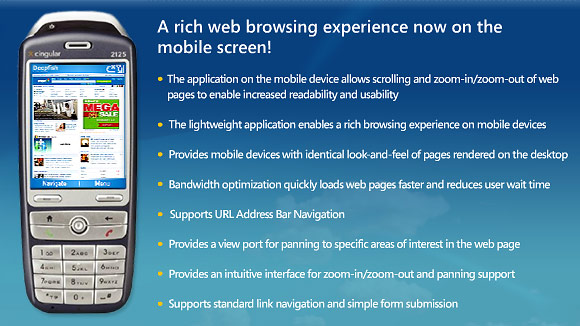 Following what might appear to be a trend for names associated with mysterious sea creatures, Microsoft’s Live Labs today announced the availability of a technology preview for its DeepFish project. Incidentally, Microsoft’s On10.net technology-enthusiast site who hyped up this announcement two days prior took a good beating.
Following what might appear to be a trend for names associated with mysterious sea creatures, Microsoft’s Live Labs today announced the availability of a technology preview for its DeepFish project. Incidentally, Microsoft’s On10.net technology-enthusiast site who hyped up this announcement two days prior took a good beating.
When you try to understand what exactly is DeepFish, the first thing that springs to mind is the Apple iPhone, which also has an intuitive web-browser built around the zoom functionality. But credit where credit is due, Microsoft has actually been developing DeepFish for a while, surfacing December last year before quickly diving into the void unknown again. It’s not so much as who thought of the idea first as who has a functional product first in the market, and that winner is Microsoft.
Although when I say functional, I literally mean the bare essentials. Don’t be fooled by the number of dots. It’s kind of weird to see “URL address bar navigation” and “links navigation” in a features list for a web-browser, but I’m also glad they had time to build in a viewport to view the web page for this beta release, as a web browser without a viewport could have been disastrous.
For anyone who’s used a browser in a screen resolution smaller than most website logos, you know how frustrating it can be and how much of a godsend this is. Let me say this even though I don’t own a Windows Mobile, this is the holy grail of internet browsing on a mobile. Regardless of whether or not Microsoft is the first to do this, this technology should be in every small-screen device no matter what brand it is.
The technology that makes DeepFish tick is interesting. It first renders a image of the webpage you request, scales it down to fit the resolution of your device, then sends it down to you.  If you want to read or interact with certain parts of the webpage, you’ll have to zoom-in to render the real page. What this means is that between you and any web server, lies Microsoft. Opera has a similar service for its Opera Mini browser where it resizes and optimizes images when you access any webpage through their browser. Both of these techniques carry significant performance enhancements, but also legal and ethical issues.
If you want to read or interact with certain parts of the webpage, you’ll have to zoom-in to render the real page. What this means is that between you and any web server, lies Microsoft. Opera has a similar service for its Opera Mini browser where it resizes and optimizes images when you access any webpage through their browser. Both of these techniques carry significant performance enhancements, but also legal and ethical issues.
Not so much with the Opera service as it is only relaying images, but Microsoft’s DeepFish relays an entire webpage. What this means is, every web page you visit, every text, every image will first go through a third-party. Whilst it is currently technically impossible to access a lot of sensitive materials without JavaScript, cookies and HTTP POST, but imagine in the future where it can do anything your desktop can, how would you feel somewhere in Microsoft, something is taking a picture of every webpage you visit?
Granted no one will or should be looking at these processes, but you can never trust the government. One day, the NSA might suspect you of conducting terrorism activities from your Treo – like every good techno-terrorist do, sends a court order to Microsoft, and they starts tracking your every move. Even if you’re not a PDA-phobic terrorist, you might just be bankrupt, but you’re checking out the 6 figures in your Swiss bank account. In that sense, it’s like someone’s always peeking over your shoulder, but you don’t know that they’re even there, so you can’t cover it up with Disney.com.
Until that day, this is the coolest thing to ever come to internet on mobile phones! 🙂
 Microsoft Japan is trying to convince people to use Windows Live through some questionable advertising. The latest of their crazy ideas is “Live Sushi” – a Flash-based interactive website which somehow ties together Windows Live Search with the art of Sushi. I don’t exactly know what it is and don’t really want to know, but on every 5 clicks, you get something like this…
Microsoft Japan is trying to convince people to use Windows Live through some questionable advertising. The latest of their crazy ideas is “Live Sushi” – a Flash-based interactive website which somehow ties together Windows Live Search with the art of Sushi. I don’t exactly know what it is and don’t really want to know, but on every 5 clicks, you get something like this… Following what might appear to be a trend for names associated with mysterious sea creatures,
Following what might appear to be a trend for names associated with mysterious sea creatures, 
 If you want to read or interact with certain parts of the webpage, you’ll have to zoom-in to render the real page. What this means is that between you and any web server, lies Microsoft. Opera has a similar service for its
If you want to read or interact with certain parts of the webpage, you’ll have to zoom-in to render the real page. What this means is that between you and any web server, lies Microsoft. Opera has a similar service for its 

 A job posted on Microsoft Careers a few days ago for a position of “
A job posted on Microsoft Careers a few days ago for a position of “ If you haven’t been following in the last week, I’ve been totally awed by what Microsoft and Ventuz has done at
If you haven’t been following in the last week, I’ve been totally awed by what Microsoft and Ventuz has done at  On March 15, Steve “
On March 15, Steve “